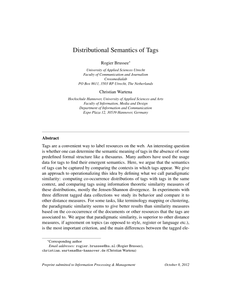Preprint submitted to Information Processing & Management Tags are a convenient way to label resources on the web. An interesting question is whether one can determine the semantic meaning of tags in the absence of some predefined formal structure like a thesaurus. Many authors have used the usage data for tags to find their emergent semantics. Here, we argue that the semantics of tags can be captured by comparing the contexts in which tags appear. We give an approach to operationalizing this idea by defining what we call paradigmatic similarity: computing co-occurrence distributions of tags with tags in the same context, and comparing tags using information theoretic similarity measures of these distributions, mostly the Jensen-Shannon divergence. In experiments with three different tagged data collections we study its behavior and compare it to other distance measures. For some tasks, like terminology mapping or clustering, the paradigmatic similarity seems to give better results than similarity measures based on the co-occurrence of the documents or other resources that the tags are associated to. We argue that paradigmatic similarity, is superior to other distance measures, if agreement on topics (as opposed to style, register or language etc.), is the most important criterion, and the main differences between the tagged elements in the data set correspond to different topics
DOCUMENT

Background: In postoperative pain treatment patients are asked to rate their pain experience on a single uni-dimensional pain scale. Such pain scores are also used as indicator to assess the quality of pain treatment. However, patients may differ in how they interpret the Numeric Rating Scale (NRS) score. Objectives: This study examines how patients assign a number to their currently experienced postoperative pain and which considerations influence this process. Methods: A qualitative approach according to grounded theory was used. Twenty-seven patients were interviewed one day after surgery. Results: Three main themes emerged that influenced the Numeric Rating Scale scores (0–10) that patients actually reported to professionals: score-related factors, intrapersonal factors, and the anticipated consequences of a given pain score. Anticipated consequences were analgesic administration—which could be desired or undesired—and possible judgements by professionals. We also propose a conceptual model for the relationship between factors that influence the pain rating process. Based on patients’ score-related and intrapersonal factors, a preliminary pain score was ‘‘internally’’ set. Before reporting the pain score to the healthcare professional, patients considered the anticipated consequences (i.e., expected judgements by professionals and anticipation of analgesic administration) of current Numeric Rating Scale scores. Conclusions: This study provides insight into the process of how patients translate their current postoperative pain into a numeric rating score. The proposed model may help professionals to understand the factors that influence a given Numeric Rating Scale score and suggest the most appropriate questions for clarification. In this way, patients and professionals may arrive at a shared understanding of the pain score, resulting in a tailored decision regarding the most appropriate treatment of current postoperative pain, particularly the dosing and timing of opioid administration.
DOCUMENT
